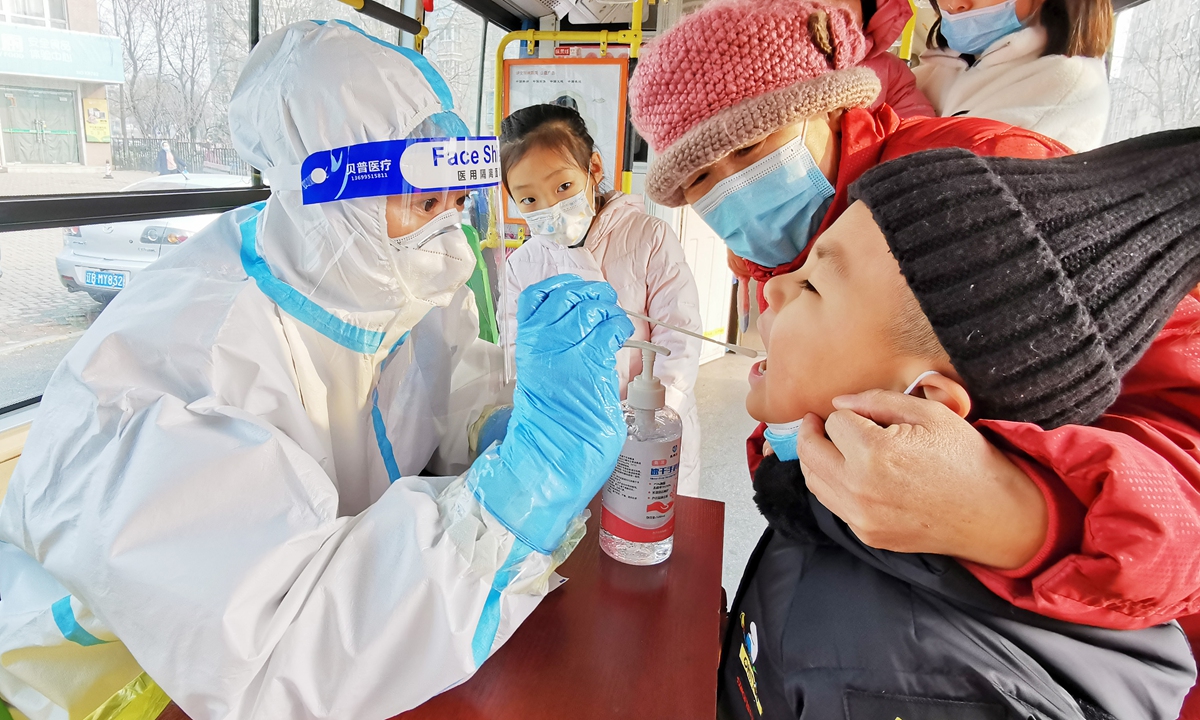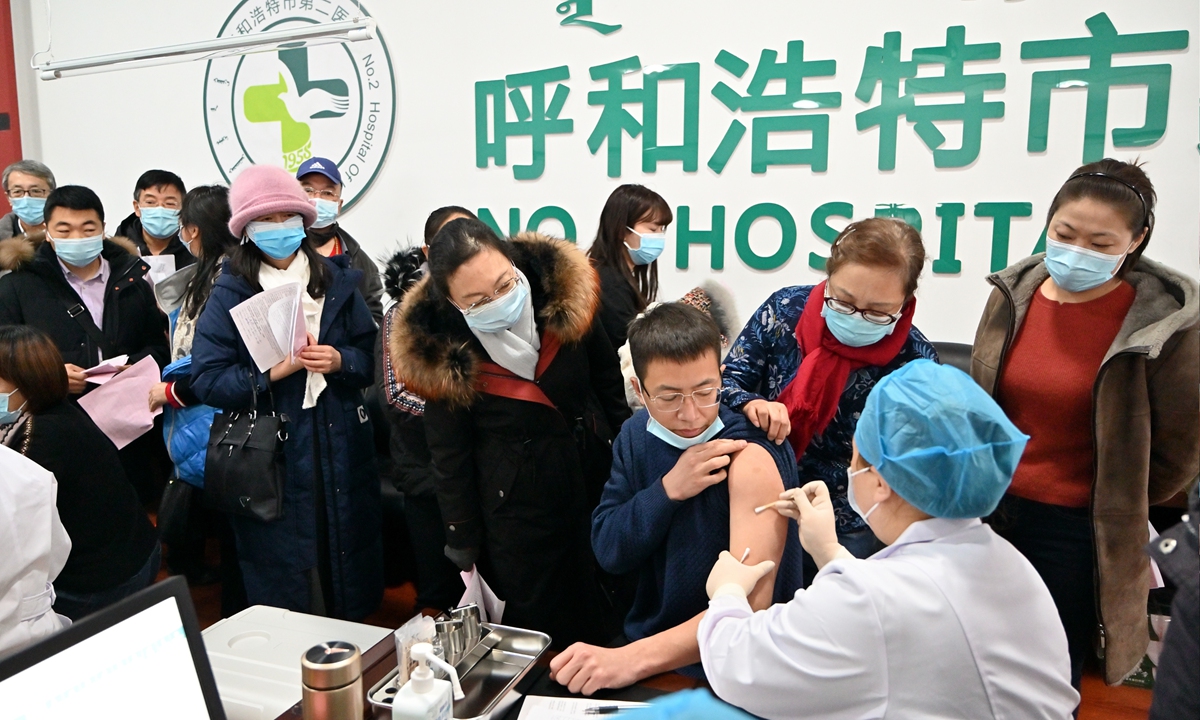China’s national epidemiological survey finds COVID-19 infection rate at low level among population
Source: Global Times Published: 2020/12/28 18:27:43

A medical worker conducts a nucleic acid test on a boy in Dalian, Northeast China's Liaoning Province on Wednesday. Dalian launched a citywide testing on Tuesday in response to a resurgence of COVID-19. On Wednesday, one new confirmed case and eight asymptomatic patients were reported in the city. Photo: VCG
China's CDC has completed a national epidemiological survey of COVID-19 serum and found that the Chinese population had a low infection rate, which experts say demonstrates China's success in bringing the epidemic under control and lays a solid foundation for carrying out mass vaccinations uniformly. .
The National Epidemiological Survey of COVID-19 Serum was conducted among some 34,000 people in over a month after China contained the first wave of the COVID-19 outbreak, which shows the positive rate of coronavirus antibodies in Wuhan, Central China's Hubei Province, was at 4.43 percent.
In other places of Hubei outside Wuhan, it was 0.44 percent. But there were only two who tested positive among 12,000 outside Hubei.
Besides Wuhan and other cities in Hubei, the survey covered four other provinces, Northeast China's Liaoning Province, East China's Jiangsu Province, South China's Guangdong Province and Southwest China's Sichuan Province, and two municipalities of Beijing and Shanghai.
In summary, the survey shows China has successfully fought the virus in the major battlefield of Wuhan, and effectively prevented it from spreading on a much larger scale as the overall population showed a low infection rate.
Successful measures
Jiang Chunlai from Jilin University's School of Life Sciences told the Global Times on Monday that he believes the investigation results indicate the real infection situation in China and demonstrate the success of China's epidemic prevention and control.
China should continue its current strict epidemic prevention and control policies, Jiang said.
Those who had contact with coronavirus-infected patients had a higher positive rate of antibodies compared to other groups, and antibody rates among seniors were higher than other age groups, according to the survey.
The serological investigation could help people find out how infectious and contagious the novel coronavirus is as well as its dynamic changes.
Epidemiologists said the investigation could help detect the proportion of asymptomatic infections and its impact on future prevention and control.
More importantly, it will help understand the proportion of those with immunity. If the proportion of herd immunity is not high, then it is impossible to prevent and control the epidemic through herd immunity. To reach the immune barrier, at least 60 percent of the population needs to be immune, they said.
Wuhan conducted the serological investigation from April 14-16 on 11,000 residents. The same investigation was conducted in other places to get a clear picture of the infection status in China.
Ding Gangqiang, a Chinese disease control official, previously said that this investigation aimed to find out the occurrence of silent carriers and the level of novel coronavirus antibodies in Chinese population to provide scientific evidence for the adjustment of anti-epidemic measures.
Tao Lina, a Shanghai-based expert on vaccines and immunology, told the Global Times on Monday that more detailed analyses and surveys should be conducted to rule out inaccurate positive cases.
As of December 26, Wuhan, a city with about 11.2 million residents, reported 50,354 COVID-19 cases, which means that the COVID-19 prevalence in the city is about 0.44 percent, significantly lower than the 4.43 percent positive rate of coronavirus antibodies revealed in the latest investigation.
"This means that there were many latent infections that had not been discovered during the Wuhan epidemic," Tao said, noting that these people possibly had not showed any symptoms and were hardly contagious.
Wuhan conducted citywide nucleic acid testing for its 11 million residents in May to find out the proportion of silent carriers and offer reference for the nation to prevent a possible resurgence of COVID-19. And the results showed that the percentage of asymptomatic patients is extremely low in the city. The previous city-wide test in Wuhan in May only took nucleic acid tests and not antibodies.

People take COVID-19 vaccine in Hohhot, North China's Inner Mongolia on Monday. Photo: cnsphoto
Good base for mass vaccination
Huang Yanzhong, a senior fellow for global health at the Council on Foreign Relations of the US, has previously warned of a potential "immunity gap" between China as the coronavirus is spreading in foreign countries and regions bringing about herd immunity.
Some countries like the UK and the US are starting to carry out mass vaccination to accelerate the process of forming herd immunity in these countries.
When these countries achieve herd immunity, most Chinese people will lack immunity as they never have been infected, as a result, an immunity gap will form. Under such circumstances, Huang told the China News Service in March that an outbreak may occur once China relaxes its anti-epidemic measures and other countries may have an excuse to continue and even expand trade or travel restrictions against China.
Tao disagreed with "herd immunity" practice, noting that China has already rolled out a national mass vaccination plan and he believes that the low antibody positive rate among Chinese residents actually provides a good base for promoting mass vaccination in the country uniformly.
"The extremely low rate means that nearly all Chinese people are susceptible to the novel coronavirus and should all accept vaccination," Tao explained.
If the positive rate reaches, for example, 20 percent, a plan should be made accordingly to separate those who have antibodies as they do not need to be vaccinated. Antigen-antibody interaction may also occur if people who have antibodies accept vaccinations, according to Tao.
China is expanding vaccination to more high-risk groups including medical workers, customs staff, cold-chain industry employees, public traffic employees and teachers. And more than 10 provinces and municipalities including South China's Guangdong, East China's Anhui, Shanghai and Southwest China's Sichuan have launched public reservations for vaccinations in recent days.
Wuhan health officials said Monday that the city had begun launching emergency COVID-19 vaccinations since December 24 on key groups, covering adults aged between 18-59 in all the 15 districts across the city.
Jiang suggests that taxi and online car-hailing drivers should also be given priority as they come into contact with a large amount of people every day.
The World Health Organization (WHO) says that it needs at least 60 to 70 percent of the population to have immunity to effectively break the chain of transmission.
China has rolled out a plan to vaccinate 50 million people of key groups by February 5 and fully provide the vaccine to the public after the drug regulator approves it.
According to a document circulating online alleged to be the records of a training session of the national disease prevention and control system on December 15, if things continue to progress well, China's inactivated vaccines are expected to be conditionally approved for market use by the year-end or early next year, with formal market approval coming as early as April.
Posted in: SOCIETY,CORONAVIRUS